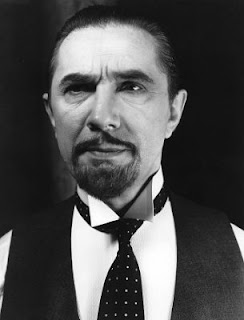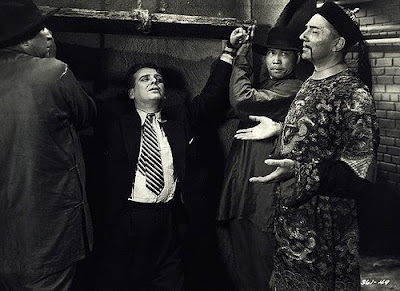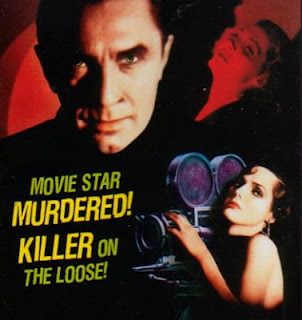By the mid-1950s, Bela Lugosi was looking at the stark reality that drug addiction had ruined his career and was threatening to end his life. As things were at their darkest, he met and was befriended by notorious hack Edward D. Wood, Jr. What Wood lacked in talent, he made up for by having a big heart, and Wood struggled to get Lugosi into rehab and to help restart his career.
The end result were two movies that brought a little light to Lugosi's darkest days and ended up being the best work that Eddie Wood would ever produce.
Glen or Glenda? (aka "I Changed My Sex") (1953)
Rating: Five of Ten Stars
Starring: Edward D. Wood, Jr., Lyle Talbot, Timothy Farrell, Deloris Fuller and Bela Lugosi
Director: Edward D. Wood Jr.
A police inspector (Talbot) puzzled by the suicide of a transvestite seeks out experts to broaden his horizons. Meanwhile, the business of the world continues, with God (Lugosi) dictating how things will turn out, even if it means that cross-dressers like Glen (Wood) will be miserable because they're different in an unaccepting world.

"Glen or Glenda?" is not a good movie. It's technically inept in just about every conceivable way and it's message is so unclear so as to be indecipherable, except for the part where it makes a plea for tolerance to those who different from the rest of us.
While this is not a good movie, it's a movie that I can't help but like for its strange imagery. I also can't help but like it, because this is the film where the rhythm and odd poetry present in Wood's dialogue is heard the clearest.
Try to listen as the film unfolds. Don't get distracted by the incomprehensible mix of images that unfold (which aren't so incomprehensible if you pay attention... if you give this movie some thought, all the pieces start falling into place). If you listen to the dialogue, you will notice that the characters have a sound to them that is very unique... a sound that we've never heard in cinema before, and a sound that we've never heard since. It's not Shakespeare, but it is unique and interesting. Wood's "voice" is also heard very loudly and effectively in "Revenge of Dr. X"; it's a film that's more painful to watch than "Glen or Glenda?", but the Poetry of Ed Wood is nonetheless present.
As for watching this movie... as badly put together as it is, there are dozens upon dozens of critics that have failed to notice even the most obvious elements in the film.
Bela Lugosi is not playing a "mad scientist". He is God/The Supreme Being in this movie... and the "Pull the strings!" line that so frequently gets mocked spells that out so clearly that I'm baffled that so many commentators describe his role in the film as "incomprehensible" and his lines as "inane babbling". And if you consider the Narrator's lines in conjunction with those spoken by Lugosi, then the fact that his character is God becomes even more clear.
Perhaps if critics and movie lovers spent more time paying attention to what is on the screen in front of them instead of looking for ways to show of their wit and self-presumed intelligence, they'd notice some of these very obvious aspects in this movie.
So, just like Ed Wood, Jr offers a plea for tolerance and understanding toward transvestites and transsexuals with this movie, I'm going to offer a plea for understanding toward this movie. Give it a second look and try to forget about all the stuff you've been spoonfed about how worthless Ed Wood movies are.
"Glen or Glenda?" is not a good movie, but it's not as bad as some critics make it out to be. It's a film that the attentive viewer will watch with fascination as it unfolds. (The inattentive viewer can have lots of fun, too... just like 90% of critics and reviews have when watching it. It remains a film that will enliven any Bad Movie Night line-up.)
Bride of the Monster (aka "Bride of the Atom") (1955)
Starring: Bela Lugosi, Loretta King, Tor Johnson, Tony McCoy, Harvey Dunn, Paul Marco, and George Becwar
Director: Edward D. Wood
Rating: Three of Ten Stars
A mad scientist (Lugosi) captures those who venture to close to his dilapitated house and subjects them to expierments intended to create a new race of radioactive supermen. When he captures a nosy female tabloid reporter (King) can it be long before his simpleminded assistant (Johnson) falls in love with her and turns on him?

"Bride of the Monster" is one of those movies that's so bad it's fun to watch if you're in the right mood and with the right group of friends. It's perfect to include in the line-up for a Bad Movie Night, because it's full of strange characters that are badly acted, situations that are badly explained and sets that are badly made, but it moves fast and has just enough redeeming features that it will keep you entertaining and laughing. (What's more, the story actually makes some degree of sense, assuming you buy into the whole mad scientist creating atomic monsters thing.)
But this is also a sad movie. Sad because it features an old and broken-down Bela Lugosi so prominanantly. When watching this movie, I feel the same sort of sorrow I felt while watching Peter Cushing in "The Masks of Death", because in both cases the ravages of age and illness are so visible on both men. It's sad to see such great talent at the point where it is about to be taken from the world forever. Lugosi's presence in this film is made twice as tragic because it's such a shoddy piece of work and because of a clumsily executed homage to one of Lugosi's greatest films, "White Zombie". (There are extreme close-ups of Lugosi's eyes, he does the same weird hand gestures he did while playing the Zombine Master, and the female victim appears hypnotized in a flowing white gown. Unfortunately, Lugosi's eyes look as old and tired as he is, the hand gesture seems out of place, and the gown is nowhere as stylish as the one in "White Zombie".)
Although Lugosi fans will feel a twinge of sadness to see him in this movie, they can take heart in the fact that he is treated better by both the script and the director than he was in any other of the films he did in his last decade on Earth. They can also take heart in the fact that Lugosi gets to act in this film. Wood lets him show a greater range than any role Lugosi had played since "The Black Cat" and "Son of Frankenstein".
No matter how old and frail Lugosi appears in this film, no matter how cheap and pathetic the quality of the sets around him, there is no denying that he gives a powerful performance.
Reportedly, Ed Wood promised Lugosi that "Bride of the Monster" would return him to stardom, and he certainly did all he could to deliver on that promise. Lugosi's scenes with George Becwar--where we learn of his character's tragic past and the depths of his madness--is great stuff. It's perhaps the best scene that Wood ever filmed. In fact, every scene that features Lugosi in this movie probably ranks among the best Wood ever filmed, and the weakness of the rest of the cast only helps to accentuate that even as a broken old man, Lugosi was an actor with great ability.
The scenes and the strange police captain and his pet bird in "Bride of the Monster" are really all the evidence that one should need to put a lie to the claim that Wood is the worst director ever. It takes actually
watching the film to realize this, though. That said, this would be a far better viewing experience if someone actually knew how to edit a film properly took a crack at reworking it.
(As a sad footnote, even if this film had been good enough to restart Lugosi's film career as Ed Wood believed, Lugosi passed away in August of 1956.)






























.jpg)






.jpg)
